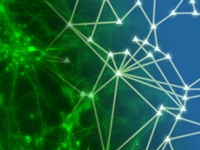The brain's circuit diagram: new method facilitates the mapping of connections between neurons
17 Oct 2012
The human brain accomplishes its remarkable feats through the interplay of an unimaginable number of neurons that are interconnected in complex networks. A team of scientists from the Max Planck Institute for Dynamics and Self-Organization, the University of Göttingen and the Bernstein Center for Computational Neuroscience, Göttingen, has now developed a method for decoding neural circuit diagrams. Using measurements of total neuronal activity, they can determine the probability that two neurons are connected with each other.
 |
| Calcium fluorescence measurements show the activity of neurons (left). From this, the scientists can deduce how the neurons are connected with each other (right). © MPI for Dynamics and Self-Organization |
The human brain consists of around 80 billion neurons, none of which lives or functions in isolation. The neurons form a tight-knit network that they use to exchange signals with each other. The arrangement of the connections between the neurons is far from arbitrary, and understanding which neurons connect with each other promises to provide valuable information about how the brain works.
At this point, identifying the connection network directly from the tissue structure is practically impossible, even in cell cultures with only a few thousand neurons. In contrast, there are currently well-developed methods for recording dynamic neuronal activity patterns. Such patterns indicate which neuron transmitted a signal at what time, making them a kind of neuronal conversation log. T
he Göttingen-based team headed by Theo Geisel, director at the Max Planck Institute for Dynamics and Self-Organization, has now made use of these activity patterns.
The scientists use data from so-called calcium fluorescence measurements that were recorded in collaboration with the University of Barcelona. This imaging method uses specially tailored molecules placed in a cell that fluoresce when they bind calcium.
Since the calcium concentration inside a neuron follows its electrical activity, it is possible to record the activity of thousands of neurons simultaneously - whether in a cell culture or in the living brain.






























